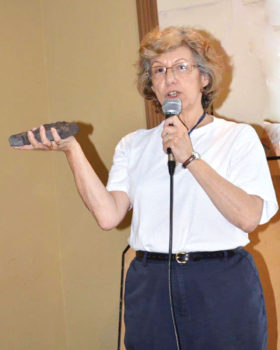
Door prize winners from left are Caraleen Ford and Jackie Hall with speaker, Gloria Quigg; Photo by Ed Skaff

Gloria Quigg; photo by Ed Skaff
Pam Boedeker
SaddleBrooke Nature Club was fortunate to have a SaddleBrooke resident as our speaker for the March meeting. Gloria Quigg is a retired Computer Specialist from the FAA. She wanted to study gems and minerals in her retired life. That began with courses at the Gemological Institute of American in Carlsbad, California. Gloria joined the SaddleBrooke Silversmith and Lapidary Club and took many classes through Tucson Parks and Recreation. She joined the Tucson Gem and Mineral Society and has taken responsibility for publicity for Tucson’s Gem and Mineral Show. Gloria continues to take classes whenever possible to study the fascinating subjects of geology and mineralogy.
Throughout Gloria’s presentation it was clear that mining has played a crucial role in the history of Arizona. It is mining that brought the settlers here and eventually made it possible for Arizona to become a state.
It was volcanic activity that created the landform and mineral deposits some 1750 years ago. In fact, those mountains you see surrounding Tucson are actually the rims of long-extinct volcanoes.
Mining has existed in Arizona throughout history, though not necessarily as we know it now. The Hohokam Indians mined clay, salt, turquoise, coral and hematite. In the mid-1500s the Spanish came looking for gold. They panned for gold and developed a crushing technique and chemicals to separate the minerals they wanted from the unwanted rock.
By the 1800s mineralogy became an accepted science. Information was shared and minerals were studied in order to make mining a more exacting industry. Mining engineers were soon educated to scout for areas most likely to produce minerals in both good quality and quantity.
By the 1900s the pneumatic drill and other advances made mining a profitable industry. Mines with their settlement towns popped up all over Arizona. Some of the major mines in Arizona were at Bisbee, Ray, La Paz, Ajo and Silverbell.
The Copper Queen Mine in Bisbee was open for 100 years. In that time it produced 8,023,252,000 tons of copper. It also produced gold, silver, lead and zinc. (That mine is open for tours and well worth the trip to Bisbee!)
Arizona has produced more non-ferrous metals than any other state.
Did you know that gold is still being mined in Arizona?
There are many stories about the rugged, adventurous people who came to Arizona originally looking for gold. It was a dirty and dangerous way to make a living. Those are the people who put Arizona on the map!
SaddleBrooke Nature Club meets the second Monday at 4:00 p.m. in the Coyote Room at the HOA 1 Clubhouse. We are a growing club and at times must move our meetings to the Gold Ranch Fire Facility. Please check our website for dates and locations of our meetings and activities.
